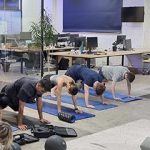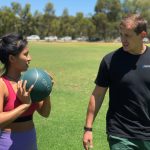Why is it important for the body to move in an efficient and functional way?
There are over 650 muscles in the body and in a perfect world they would all work effectively with one another to produce ideal and efficient movement in all situations. This is not the case and in my view as a personal trainer it is essential to not only help clients achieve their health goals but also teach them what ideal movement looks and feels like. It is unlikely that anyone will ever move in a biomechanically perfect way throughout their whole life. However, it is extremely likely that you will have some degree of dysfunction in your movement. Addressing this and aiming to improve it is going to have you moving better, and greatly reduce if not solve musculoskeletal pain you currently have or are likely to attain in the future due to poor movement patterns.
It is also important to understand the downfalls of performing certain movements when you have dysfunctional patterns. Reinforcing these patterns through potentially dangerous exercises such as heavy barbell back squats and ballistic training will typically lead to injury.
How does our body learn to move in less than ideal ways?
The number one priority of the body is to make sure you keep moving. The body does what is has to in order to get the conscious movement outcome we desire. An example of this is, if you have weak glutes that are not extending your leg behind you to their full capacity, other muscles will help to do this, typically the hamstrings in this scenario take on more work than they were designed to. This can lead to a hamstring injury. Another example would be if we have an ankle injury. In order to walk we will limp around. As you can see here we still move to where we desire, we just do it in a way where other muscles have to compensate and do jobs they are not ideally designed for to help us out.
Without getting to technical the most important thing to understand is, if a muscle isn’t functioning in the ideal way, the body will work out a way around it to make sure you are still moving. It is also important to understand that the body may last years in this dysfunctional state before any problems come to light due to chronic pain or injury.
So what is the path from dysfunctional to functional?
At Functional For Life we see moving in a functional and efficient way as ‘the essential foundation’ to all movement. The approach to improving our movement is to progress step by step, towards this by working on the following areas:
Mobilizing the joints: typically hips, shoulders and ankles are the joints where movement can be restricted. Freeing up the muscles/joint through SMR (see below), stretching and a technique called banded distractions help to mobilize the joint.
Self Myofascial Release (SMR): This is a technical word for self-massage. Foam rolling and massage balls are commonly used for this. Addressing the right areas is the key to using these.
Learn and stabilize new ranges of motion– Once you have worked to improve your joints range of motion (ROM) the next step is to learn to control the movements in that new ROM. This helps to reinforce the new movement pattern.
Reinforce new movement pattern– All movements start when the brain fires signals to the relevant muscles to do their job. If you are moving with dysfunction the firing patterns are going to be off. For example, some muscles might be firing harder than they should, some muscles might not be performing the best they can due to concepts such as prolonged reciprocal inhibition (think glutes when sitting all day). To move better we need to train our body to perform movements correctly through repetition and focusing on quality of movement over quantity/intensity.
Functional Integration– Once the new movements have been taught and reinforced, it is then important to apply them to real life ‘functional situations’ so they can be applied in a practical setting. For example practising squats as squats mimic getting in and out of a chair, a common movement in day to day life.
What is the end goal here?
To be clear there is no one size fits all model for any of this. Everyone is going to be somewhere on the spectrum from highly functional and efficient movement to highly dysfunctional and inefficient movement. Therefore, some people will take longer to get to a situation where their movement is high quality. However, the end goal of ensuring our movement foundation is highly efficient means better movement outcomes i.e. more power and strength available when performing exercise and a dramatic decrease in the risk of injury. Most importantly understanding what efficient and functional movement looks and feels like as well as how to work towards it, means high quality movement for your life and improving movement longevity!
Thanks for reading and for more advice and tips on functional movement check out our blog. All the best with your training and health goals!






